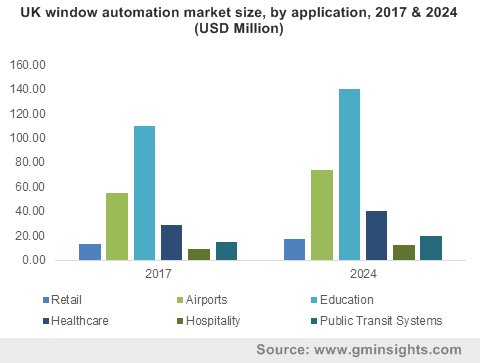Window automation market to amass lucrative returns from the commercial sector, global valuation to exceed USD 8 billion by 2024
Publisher : Fractovia | Published Date : 2017-04-21Request Sample
The rapidly shifting trends toward green infrastructure has generated a plethora of opportunities for window automation market players. The lure of a modern, highly-efficient standard of living is on the rise owing to increasing disposable incomes, the impact of which has been felt across the construction sector. Quite overtly, building contractors are now on the lookout for ways to automate commercial and residential spheres to deliver the comfort of a modern, smart, enhanced, and energy-efficient living space. In consequence, this has had a remunerative impact on window automation market size, valued at USD 5 billion in 2017.
UK window automation market size, by application, 2017 & 2024 (USD Million)

The automation sector currently embodies a slew of novel solutions and product innovations by well-known players, the influence of which is felt on window automation industry outlook. GEZE for instance, one of the prominent participants of window automation market and a reliable partner for door and window safety technologies, in 2017, brought forth a synergy of traditional building automation technologies and modern solutions with the integration of automated doors and windows. Installing the standard KN protocol was also touted to help optimize the network of these automated window systems to conveniently incorporate these into a building automation system. GEZE’s initiative toward developing intelligent automated systems for building components is an indication of how effortlessly smart technology has enmeshed itself in the construction arena.
The smart building tech industry has indeed progressed at an exponential level ever since its inception, periodically offering a spate of high growth opportunities for window automation market giants. Windows are particularly significant in the equation of energy loss or gain, as buildings lose a pivotal amount of energy solely through windows. As per the US Green Building Council (USGBC), a glass pane can gain or lose up to 10 times the amount of heat than a wall space of the same size. In this context, window automation industry contenders have been brainstorming highly advantageous solutions since quite a while now.
A notable instance testifying the authenticity of the aforementioned statement is that of View, Inc., the California headquartered glass systems manufacturer. Quite a few years ago, View had been selected by the W Hotel in San Francisco to replace its conventional lobby windows with smart windows. The resultant design effectuated automated windows that would automatically tint to block glare and heat during the summer months, while being able to adjust to a lesser level when the weather was murky. Since then, there has been no looking back for this giant – today, View’s windows are installed in more than 200 commercial buildings, inclusive of schools, office spaces, public structures, and hospitals. In fact, a couple of years back, the company had been selected to install 100,000 square feet of windows at America Center II, the USAA Real Estate Company. On these grounds, View has been aptly named as one of the most dominant players of window automation market, specifically in commercial applications.
Speaking along similar lines, the last half a decade has observed a higher installation of automated windows in the commercial sector as opposed to the residential and industrial sectors. The extensive requirement for energy efficiency across airports, universities, schools, retail stores, hotels, hospitals, and public transit systems has generated a commensurable pool of opportunities for window automation market players in the commercial sector. These systems are specifically installed in buildings with high roofs, where manual operations are virtually impossible. Powered by the fact that they are convenient, efficient, and aid the reduction of capital expenditure, window automation industry size from commercial applications is projected to grow at CAGR of 6% over 2018-024.
Despite the projected critical acclaim that window automation market will garner, escalating product prices remain a major constraint for this business space. Indeed, lowering the costs of energy efficient technologies has been one of the principal challenges for energy magnates for a while now. The solution comes in the guise of deploying green manufacturing technologies and manufacturing inexpensive energy-efficient devices. Say for instance, commercial infrared-blocking windows, both passive and active, in spite of possessing the ability to block radiation and contribute to energy efficiency, are way too expensive to be installed on a large scale. However, using cheaper metals instead of silver could reduce the cost of the heat-blocking window technology and ensure that they are widely adopted, thereby increasing the commercialization scope of window automation market.
As per estimates, by 2050, more than 66% of the global population will be living in the urban landscape, increasing the demand for energy-efficient buildings and the subsequent components such as smart doors and windows. Amidst this backdrop, it is essential that in order to ensure maximum efficiency in automated windows, the stalwarts of the construction domain – manufacturers, designers, and installers need to work in seamless co-ordination and deliver an enhanced product. As the significance that green cities hold for a sustainable, low-carbon future, energy-neutral buildings are likely to soon dominate the construction domain, a move that will substantially augment window automation market trends.